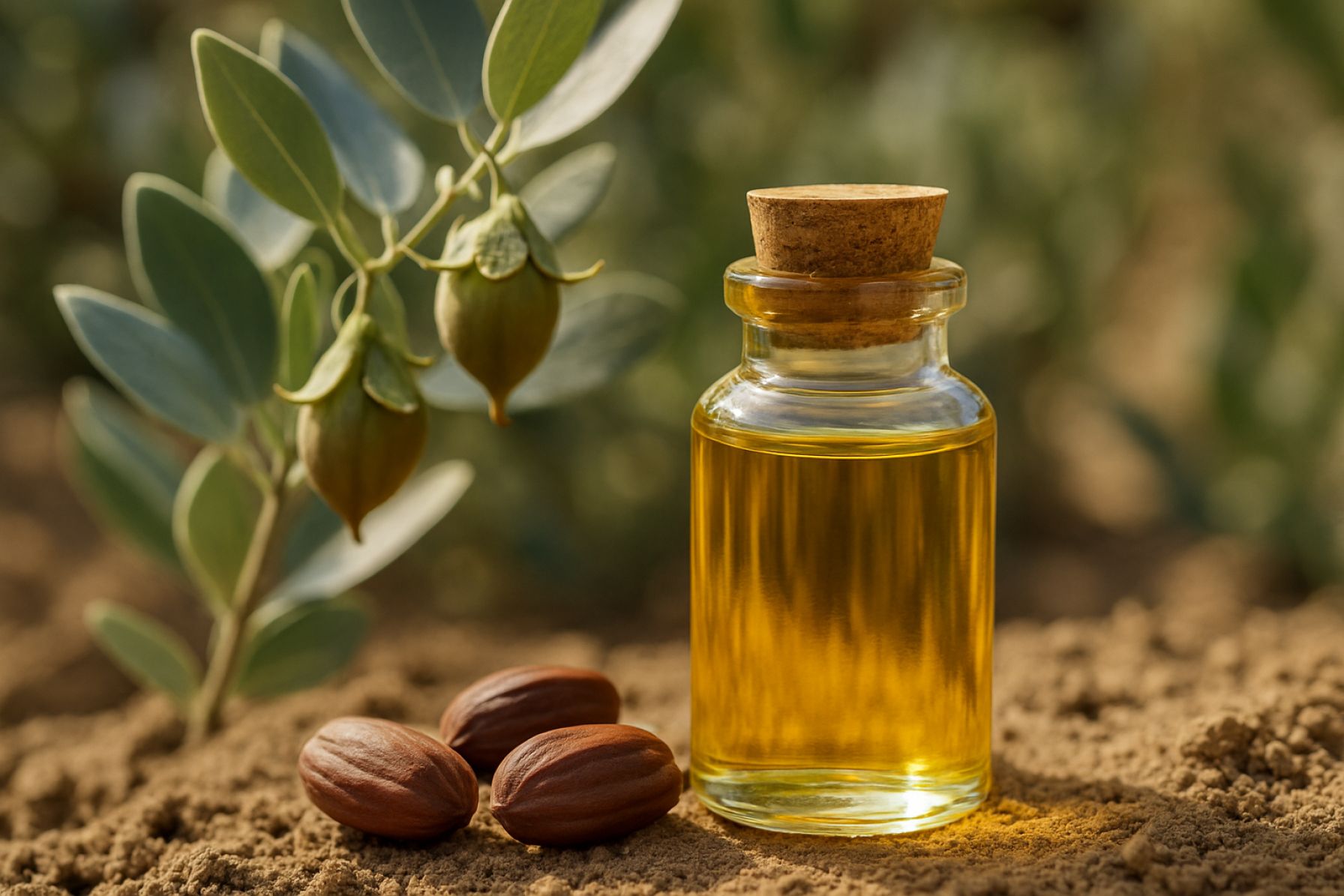
Table of Contents
- Executive Summary: Key Insights for 2025 and Beyond
- Industry Overview: Jojoba Oil in the Cosmetic Sector
- Current Extraction Technologies: Methods, Efficiencies, and Challenges
- Emerging Innovations: Cold Press, Enzyme-Assisted, and Supercritical CO2 Extraction
- Market Forecasts 2025–2030: Global Demand, Pricing Trends, and Growth Hotspots
- Sustainability and Green Processing: Environmental Impact and Industry Initiatives
- Key Players and Company Strategies: Leaders in Jojoba Extraction (e.g. desertwhale.com, hallstar.com)
- Patent Landscape and R&D: Recent Advances and Proprietary Technologies
- Regulatory Outlook: Compliance, Certifications, and Quality Standards
- Future Opportunities and Challenges: What’s Next for Jojoba Oil Extraction?
- Sources & References
Executive Summary: Key Insights for 2025 and Beyond
The extraction of jojoba oil for cosmetic applications is undergoing notable transformation as the industry pivots toward higher efficiency, sustainability, and product purity. As of 2025, mechanical cold pressing remains the industry standard for jojoba oil extraction due to its ability to preserve the oil’s bioactive compounds and meet the stringent requirements of cosmetic formulators. Leading producers such as The Jojoba Company and Desert Whale Jojoba Company continue to invest in advanced cold press machinery that maximizes yield and minimizes thermal degradation, a critical factor for maintaining the oil’s stability and antioxidant profile.
Emerging trends in the sector point toward the adoption of greener, more energy-efficient extraction methods. Supercritical CO2 extraction technology has gained traction for its ability to produce solvent-free, premium-grade jojoba oil with minimal environmental impact, though its higher capital cost remains a barrier for broad adoption. Companies such as Natural Plant Products have publicly highlighted ongoing research and pilot-scale deployment of supercritical fluid extraction, aiming to enhance scalability and cost-effectiveness over the next several years.
Organic and traceability certifications increasingly shape investment in extraction infrastructure. Producers are responding to consumer and regulatory demands for clean beauty by integrating certification-compliant processes and digital traceability systems. Sime Darby Oils and Innovacos are among those prioritizing sustainable sourcing, with extraction lines designed to minimize waste and enable circular use of byproducts—such as using pressed seed cake in animal feed or soil amendments.
Looking ahead, the outlook for jojoba cosmetic oil extraction is defined by the convergence of technology innovation and sustainability imperatives. Automation, real-time process monitoring, and AI-driven quality assurance are expected to become more prevalent by 2027, further optimizing yields and consistency. Industry leaders are also exploring hybrid extraction platforms that combine mechanical and green solvent systems, targeting higher-value specialty cosmetic ingredients. As the beauty sector’s emphasis on eco-responsibility intensifies, extraction technologies that deliver both purity and environmental stewardship will shape the competitive landscape for years to come.
Industry Overview: Jojoba Oil in the Cosmetic Sector
The extraction of jojoba oil for cosmetic applications has undergone significant advancements, driven by growing demand for natural, sustainable ingredients and the expanding global cosmetics market. Jojoba oil, prized for its stability and resemblance to human sebum, is primarily obtained from the seeds of the Simmondsia chinensis shrub. As of 2025, the industry continues to refine its extraction technologies to maximize yield, preserve bioactive compounds, and minimize environmental impact.
Cold pressing remains the most widely adopted extraction method within the cosmetic sector, favored for its ability to retain the oil’s natural properties without the need for solvents or high temperatures. Companies such as Desert Whale Jojoba Company and Vantage Specialty Ingredients utilize proprietary cold-pressing processes, ensuring the oil remains unrefined and rich in vitamins and antioxidants. These processes are continually being optimized; for instance, improvements in seed pre-conditioning and mechanical press design have led to higher yields and reduced energy consumption.
Supercritical CO2 extraction has emerged as a promising alternative, offering solvent-free extraction while preserving sensitive constituents. This technology, although more capital-intensive, is being explored by innovative producers targeting premium cosmetic formulations. Jeen International and Allan Chemical Corporation have both reported development or sourcing of jojoba oil extracted using supercritical CO2, emphasizing its purity and enhanced shelf-life for luxury skincare brands.
Sustainability is a primary concern, with manufacturers increasingly investing in closed-loop processing, energy-efficient equipment, and water recycling systems. For example, Lipo Chemicals highlights the integration of green extraction technologies and waste minimization practices throughout their jojoba oil supply chain. Such sustainability initiatives are likely to shape the sector’s competitive landscape in the coming years.
Looking ahead, the period from 2025 onward is expected to see further adoption of hybrid extraction techniques that combine cold pressing with mild enzymatic treatment or ultrasound-assisted extraction. These methods promise even greater yields and a more favorable environmental footprint. Industry leaders are also collaborating with equipment manufacturers to design presses and filtration systems tailored to jojoba seeds’ unique characteristics, supporting scalability and consistent oil quality.
Overall, ongoing innovation in extraction technology is poised to enhance both the quality and sustainability of jojoba oil for the cosmetic industry, aligning with consumer demand for clean-label, ethically sourced ingredients.
Current Extraction Technologies: Methods, Efficiencies, and Challenges
Jojoba oil, prized for its similarity to human sebum and stability in cosmetic formulations, is primarily extracted from the seeds of the Simmondsia chinensis shrub. The extraction technologies employed in 2025 continue to evolve with an emphasis on maximizing yield, preserving bioactive components, and ensuring environmental sustainability.
Traditionally, mechanical cold pressing remains the industry standard for jojoba oil extraction, favored for its ability to produce high-quality, unrefined oil with minimal chemical alteration. Companies such as Desert Whale Jojoba Company, Inc. and International Flavors & Fragrances Inc. (IFF) continue to invest in advanced cold press systems that optimize seed throughput and reduce energy consumption. Cold pressing typically yields about 45–50% oil by weight from cleaned, dehulled seeds, with the resultant oil requiring only minimal filtration and refining to meet cosmetic industry standards.
Solvent extraction, though less common for premium cosmetic applications due to regulatory and purity concerns, is still utilized at scale for industrial-grade jojoba oil. This method leverages food-grade solvents such as hexane to improve extraction efficiency, recovering up to 60% of the total oil content. However, solvent residues and the loss of certain unsaponifiable fractions limit its acceptability for high-end cosmetic products. As a result, companies like Eurochem Group are focusing research on green solvents and supercritical fluid extraction, aiming to enhance both yield and sustainability.
Supercritical CO2 extraction represents a cutting-edge alternative, offering solvent-free processing and improved preservation of sensitive wax esters and vitamins. While this technology is capital-intensive, recent years have seen pilot implementations by innovators such as Natural Oils International, reporting higher purity and oxidative stability in the final oil. However, challenges remain regarding scalability and operational costs, limiting widespread adoption in 2025.
Emerging techniques, including enzymatic-assisted extraction and ultrasound-assisted extraction, are under exploration, targeting further improvements in yield and environmental performance. Companies are partnering with academic institutions to pilot these approaches, though commercial-scale deployment is expected to remain limited over the next few years due to technical and regulatory hurdles.
The outlook for jojoba oil extraction technologies over the next several years involves incremental improvements in established methods, gradual adoption of supercritical CO2 extraction for niche and premium cosmetic oils, and ongoing research into more sustainable and efficient processes. Industry leaders are expected to prioritize innovations that balance product quality, cost-effectiveness, and environmental stewardship to address evolving market and regulatory demands.
Emerging Innovations: Cold Press, Enzyme-Assisted, and Supercritical CO2 Extraction
In 2025, the extraction of jojoba oil for cosmetic applications is witnessing a surge in technological innovations, with cold press, enzyme-assisted, and supercritical CO2 extraction methods gaining prominence. These advancements are driven by increasing consumer demand for high-purity, sustainably produced oils, as well as stricter industry regulations for cosmetic ingredients.
Cold Press Extraction: The cold press method remains the industry standard for premium jojoba oil production, favored for its ability to preserve the natural composition of fatty acids, vitamins, and antioxidants. Key producers such as Desert Harvesters and Jojoba Company highlight their proprietary cold press systems, which operate under controlled temperatures to minimize thermal degradation of bioactive compounds. In 2025, automation and scale-up of cold press facilities are allowing manufacturers to meet growing global demand while maintaining consistency in oil quality.
Enzyme-Assisted Extraction: Enzyme-assisted extraction is gaining traction as a method to boost oil yield and reduce processing waste. This technique utilizes specific enzymes to break down plant cell walls, facilitating the release of oil with lower energy input. Companies like Nikken Foods are piloting enzyme cocktails tailored to jojoba seeds, with early data suggesting up to a 15% increase in extraction efficiency compared to traditional mechanical methods. This approach also aligns with sustainability goals by reducing solvent usage and minimizing environmental impact.
Supercritical CO2 Extraction: Supercritical CO2 extraction is emerging as a cutting-edge solution for producing ultra-pure jojoba oil, free from solvent residues. In 2025, industry leaders such as FLAVEX Naturextrakte have expanded their supercritical CO2 extraction capabilities, offering bespoke extraction parameters to preserve delicate aroma and bioactive fractions. This method is particularly attractive for high-end cosmetic formulations, where purity and traceability are paramount. While capital costs remain higher than traditional methods, continued process optimization is expected to lower barriers to adoption over the next few years.
Outlook: As the cosmetics industry prioritizes ingredient transparency and eco-friendly sourcing, innovation in jojoba oil extraction is set to accelerate. Collaboration between equipment manufacturers, ingredient suppliers, and cosmetic brands will likely drive further advances in extraction efficiency, sustainability, and product customization, positioning jojoba oil as a leading ingredient in the clean beauty movement through 2025 and beyond.
Market Forecasts 2025–2030: Global Demand, Pricing Trends, and Growth Hotspots
The global market for jojoba cosmetic oil is poised for significant growth between 2025 and 2030, driven by advancements in extraction technologies, rising consumer demand for natural ingredients, and expanding applications in skincare and personal care products. Modern extraction methods, notably cold-pressing and supercritical CO2 extraction, are gaining traction for their ability to yield high-quality oil with minimal environmental impact and superior purity. Industry leaders such as Desert Whale Jojoba Company and Vantage Specialty Chemicals are expanding their production infrastructure to incorporate these technologies, aiming to meet the increasing requirements of global cosmetic formulators.
Recent years have witnessed a shift from traditional solvent extraction methods to more sustainable and efficient techniques. Cold-pressing, favored for retaining the oil’s natural nutrients and minimizing solvent residues, is now widely adopted by major producers. Meanwhile, supercritical CO2 extraction is being explored and scaled up by companies such as Eco Joba, who emphasize its ecological benefits and ability to produce pharmaceutical-grade jojoba oil. These technological upgrades are expected to reduce processing costs and enhance product purity, positively impacting pricing dynamics over the forecast period.
Market analysts anticipate that the compounded annual growth rate (CAGR) for jojoba oil extraction technologies in the cosmetic sector will exceed 7% through 2030, especially in Asia-Pacific and North America where demand for premium, sustainable cosmetic ingredients is surging. Strategic investments in extraction capacity and quality control are noted among key suppliers, including The Jojoba Company Australia and Hallstar, who are leveraging proprietary methods to differentiate their product offerings.
Pricing trends are expected to remain robust, supported by stable raw material supply from established cultivation regions in the U.S., Israel, and Australia. However, sporadic climate impacts on jojoba crop yields may introduce moderate price volatility. Growth hotspots identified for the next five years include China, India, and the Middle East, where the adoption of eco-friendly cosmetic formulations is accelerating. In these regions, technology transfer and local extraction partnerships are anticipated to play a pivotal role in scaling up production while adhering to stringent quality and sustainability standards outlined by industry groups such as the International Jojoba Export Council.
Sustainability and Green Processing: Environmental Impact and Industry Initiatives
In 2025, sustainability and green processing are central themes driving innovation in jojoba cosmetic oil extraction technologies. The industry is increasingly focused on reducing environmental impact across the entire value chain—from cultivation and harvesting to oil extraction and waste management. This shift is fueled by consumer demand for eco-friendly products, regulatory pressures, and the environmental stewardship goals of major players in the natural cosmetics sector.
Traditional jojoba oil extraction methods, such as mechanical cold pressing, are favored for their minimal chemical usage and low energy input. Companies like Desert Whale Jojoba Company and International Jojoba Export Company have long adopted cold pressing, emphasizing its ability to yield high-quality oil without solvents, thereby minimizing emissions and toxic byproducts. Recent technological advances now enable more efficient oil recovery and lower energy consumption, with some processors integrating renewable energy sources, such as solar-powered presses, into their operations.
Solvent extraction—while offering higher yields—has come under scrutiny due to potential environmental hazards from solvent residues and waste. In response, manufacturers like Natural Oils International are investing in closed-loop solvent systems and green solvents (e.g., ethanol derived from biomass), which reduce emissions and recycle solvents to decrease their environmental footprint. These initiatives are aligned with global sustainable sourcing standards and certifications.
Beyond extraction, sustainability initiatives extend to byproduct valorization and water conservation. For instance, Jojoba Farma has implemented circular economy strategies by repurposing extraction residues as animal feed or organic fertilizers, thereby reducing waste and creating additional value streams. Other companies are investing in advanced irrigation systems and drought-resistant jojoba cultivars to minimize water usage, a critical factor for jojoba farms in arid regions.
- Industry outlook: Over the next few years, the jojoba oil sector is expected to further embrace green extraction technologies, with a strong emphasis on lifecycle assessment, carbon footprint reduction, and transparent sustainability reporting. The adoption of eco-certifications and traceability platforms will likely become industry norms, driven by both regulatory developments and consumer expectations for environmentally responsible cosmetics.
- Collaboration: Cross-sector partnerships—such as those between growers, processors, and cosmetic brands—are anticipated to accelerate the development and scaling of greener extraction processes.
Overall, sustainability in jojoba oil extraction is rapidly evolving, positioning the industry at the forefront of environmental responsibility within the botanical oils sector.
Key Players and Company Strategies: Leaders in Jojoba Extraction (e.g. desertwhale.com, hallstar.com)
The jojoba cosmetic oil sector continues to experience robust innovation and strategic expansion, driven by leading extraction technology providers and ingredient specialists. As of 2025, established players are refining extraction processes to maximize oil yield, purity, and sustainability, in response to growing demand from skincare, haircare, and personal care brands prioritizing natural and eco-conscious ingredients.
Desert Whale Jojoba Company, a division of Vantage Specialty Chemicals, remains a pioneer in jojoba oil extraction technologies. The company employs proprietary mechanical pressing and advanced filtration methods that minimize the need for chemical solvents, ensuring a high degree of purity and preserving the oil’s natural tocopherols and fatty acids. In recent years, Desert Whale has invested in enhancing traceability from seed sourcing to finished oil, integrating blockchain-based supply chain monitoring to support their sustainability commitments. Their focus on eco-friendly processing aligns with the surging consumer demand for clean-label cosmetics, positioning them as a preferred supplier for brands seeking transparency and green chemistry credentials (Vantage Specialty Chemicals).
Another key innovator, Hallstar Beauty, has expanded its jojoba-based ingredient portfolio by leveraging cold-press extraction and molecular distillation technologies. These methods enable the production of highly stable jojoba esters and derivatives with customizable emollient profiles for diverse cosmetic formulations. In 2025, Hallstar is focusing on R&D collaborations to develop multifunctional jojoba complexes—such as encapsulated actives and dispersible waxes—that address both performance and sensory trends in the beauty sector. Their extraction strategy also emphasizes energy efficiency and waste minimization, reflecting industry-wide moves toward circular production models (Hallstar Beauty).
Additionally, International Flavors & Fragrances Inc. (IFF) has strengthened its presence in the jojoba supply chain following its acquisition of key natural ingredient producers. IFF utilizes supercritical CO₂ extraction and low-temperature processing to optimize oil quality for sensitive skin applications, while scaling up organic and fair-trade sourcing networks to meet evolving regulatory and consumer expectations (IFF).
Outlook for the next few years indicates intensified competition around proprietary extraction technologies that enhance oil bioactivity and sustainability. Leading companies are expected to further automate extraction lines, invest in renewable processing energy, and introduce certified upcycled jojoba co-products, reinforcing their leadership in the fast-evolving cosmetic oil landscape.
Patent Landscape and R&D: Recent Advances and Proprietary Technologies
The patent landscape for jojoba cosmetic oil extraction technologies has grown increasingly active in 2025, driven by rising demand for high-purity, sustainably produced jojoba oil in the cosmetics sector. Companies are focusing on innovations that improve extraction yields, preserve bioactive components, and lower environmental impact. Recent years have witnessed a shift from traditional solvent extraction to more advanced techniques such as supercritical CO2 extraction and enzymatic processes, both of which are being patented and scaled for commercial use.
Several industry leaders are investing in proprietary extraction methods. Desert Whale Jojoba Company, a subsidiary of Vantage Specialty Ingredients, holds patents for mechanical cold pressing and has developed eco-friendly extraction processes specifically tailored for cosmetic-grade oil, optimizing both purity and stability of the final product. Their R&D division is currently exploring enzymatic enhancement steps to further increase oil yield while reducing processing time.
Another major player, The Jojoba Company Australia, has reported ongoing research into solvent-free extraction technologies. Their proprietary processes emphasize sustainability and product traceability, with pilot-scale results in 2024 leading to plans for commercial rollout by 2026. The company is also collaborating with academic institutions to patent novel filtration steps that retain more tocopherols and wax esters, key bioactives valued in skincare formulations.
In Israel, Jojoba Desert (A.C.S.) Ltd. continues to expand its intellectual property portfolio. The company’s recent patents focus on process optimization for cold-pressed extraction, including innovations in seed pre-conditioning and oil clarification, aimed at maximizing the sensory and functional qualities of jojoba oil for high-end cosmetics.
Global industry bodies such as the Personal Care Products Council have noted a surge in patent filings and cross-licensing of green extraction technologies among members, reflecting a push toward cleaner, more efficient production processes. This trend is reinforced by consumer demand for transparent sourcing and clean-label cosmetics.
Looking ahead, the patent landscape is expected to become more competitive as companies seek to protect novel extraction processes, particularly those involving hybrid mechanical-enzymatic methods and continuous-flow supercritical CO2 systems. R&D investment is anticipated to remain strong through at least 2027, with industry collaboration and technology transfer likely to accelerate the adoption of these advanced extraction technologies across global supply chains.
Regulatory Outlook: Compliance, Certifications, and Quality Standards
The regulatory landscape governing jojoba cosmetic oil extraction technologies in 2025 is increasingly stringent, reflecting heightened consumer demand for transparency, sustainability, and product safety. Compliance with global and regional standards is now a prerequisite for market access, particularly in major cosmetics-consuming regions such as the European Union, North America, and parts of Asia.
Key international standards, such as ISO 16128 for natural and organic cosmetic ingredients, guide manufacturers in substantiating natural claims for jojoba oil. Adherence to Good Manufacturing Practice (GMP) protocols—outlined in ISO 22716—is also widely mandated to ensure product quality and traceability throughout the extraction and refinement process. Companies like Desert Whale Jojoba Company and Lipotec publicize their certifications and GMP compliance, underscoring the role of third-party verification in building consumer trust.
Organic certification remains a pivotal differentiator in the marketplace. Bodies such as USDA Organic and ECOCERT require not only pesticide-free cultivation but also certified extraction and processing methods. International Collection Oils and SOPHIM highlight their organic certifications, which are increasingly demanded by premium cosmetic brands.
Moreover, regional regulatory frameworks are evolving. The EU’s REACH regulation obliges companies to demonstrate the safety of extracted jojoba oil, particularly with respect to potential contaminants or residues from extraction solvents. There is a marked trend toward solvent-free extraction technologies, such as cold-pressing and supercritical CO₂ extraction, designed both to meet regulatory requirements and to cater to the clean beauty movement. Industry players like Desert Whale Jojoba Company and SOPHIM are investing in such technologies and openly detail their processes.
Looking ahead, sustainability certifications—such as the Roundtable on Sustainable Biomaterials (RSB)—are expected to gain traction, especially as brands seek to demonstrate environmental stewardship in sourcing and extraction. Increased traceability, digital batch tracking, and full supply chain transparency are likely to become standard practice by 2027–2028, as regulatory bodies and consumers alike demand greater assurance of quality and ethical sourcing practices in jojoba oil extraction.
Future Opportunities and Challenges: What’s Next for Jojoba Oil Extraction?
The landscape of jojoba oil extraction technologies is rapidly evolving, driven by rising demand in the cosmetics sector for high-purity, eco-friendly oils. As of 2025, leading producers are investing in both optimizing traditional methods and exploring innovative solutions to address efficiency, sustainability, and quality concerns.
Traditionally, mechanical cold pressing has been the gold standard for cosmetic-grade jojoba oil, as it preserves the oil’s unique liquid wax esters and minimizes thermal degradation. Companies like Desert Essence and JEEN International continue to rely on cold press extraction, marketing their products as minimally processed and environmentally responsible. However, cold pressing typically yields 40–50% of available oil, leaving room for technological improvement.
Supercritical CO2 extraction is garnering increased attention for its ability to enhance yield and purity without harmful solvents or excessive heat. Recent advances have made this technology more scalable and cost-effective, with suppliers such as Vantage Specialty Chemicals introducing jojoba oils extracted using this method for the personal care market. Supercritical CO2 techniques can increase extraction yields up to 70%, while producing oils with extremely low residual impurities, aligning with stricter regulatory and consumer requirements for cosmetic ingredients.
Looking ahead, the sector faces several challenges and opportunities. Sustainability pressures are pushing manufacturers to reduce water and energy use, minimize waste, and improve traceability. For instance, International Flavors & Fragrances Inc., a supplier of jojoba derivatives, is exploring closed-loop extraction systems and renewable energy integration to lower the carbon footprint of their operations. Innovations in enzymatic pre-treatment and green solvents are also on the horizon, potentially enabling higher oil recovery from seeds and further improving environmental performance.
- Outlook 2025–2028: Growth in the natural cosmetics market is expected to sustain high demand for jojoba oil, motivating continued investment in advanced extraction infrastructure and process automation. Companies will likely prioritize technologies that deliver not only higher yields but also verifiable sustainability credentials.
- Key Challenge: Ensuring that new extraction technologies remain cost-competitive is essential, as raw material prices and regulatory scrutiny intensify.
- Opportunity: Producers capable of certifying sustainable sourcing and clean extraction methods will gain access to premium cosmetic segments and global formulators, as evidenced by increasing partnerships between extraction specialists and major beauty brands.
In summary, the next few years will see jojoba oil extraction technologies advance along two main axes: maximizing efficiency and aligning with green chemistry principles, securing jojoba’s role as a cornerstone natural cosmetic ingredient.



